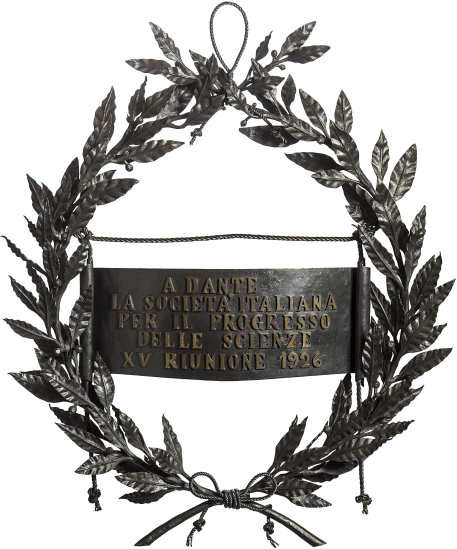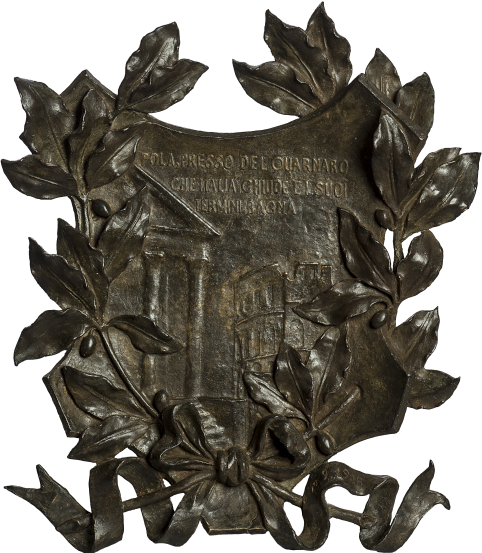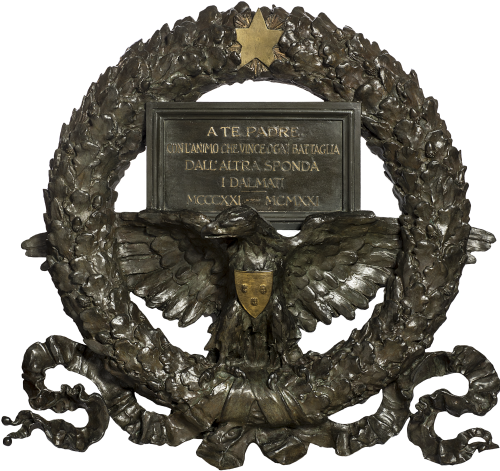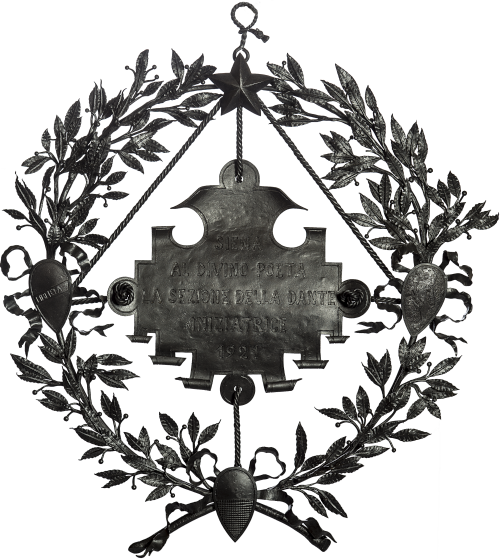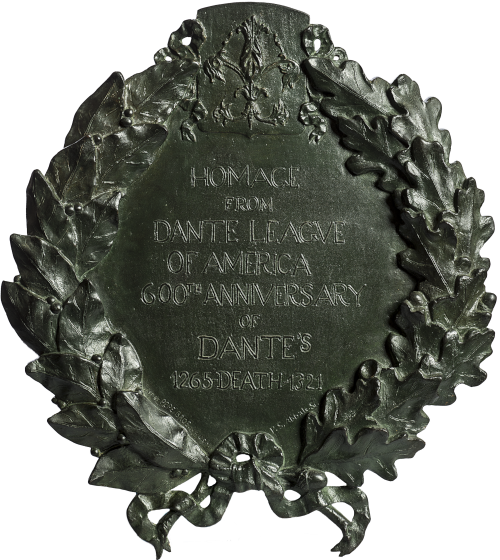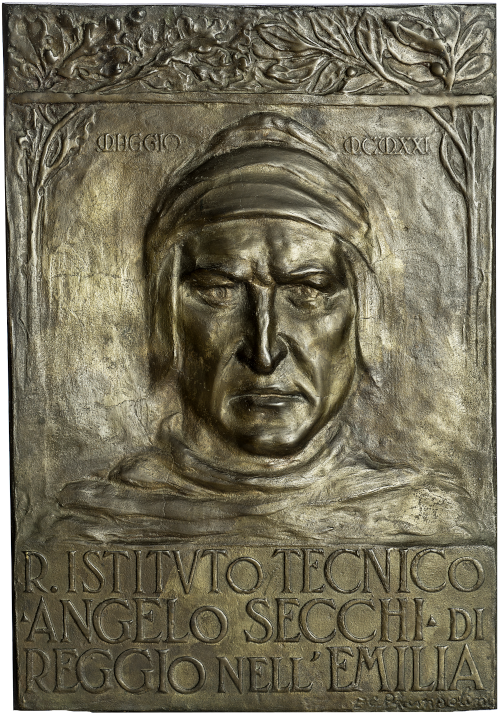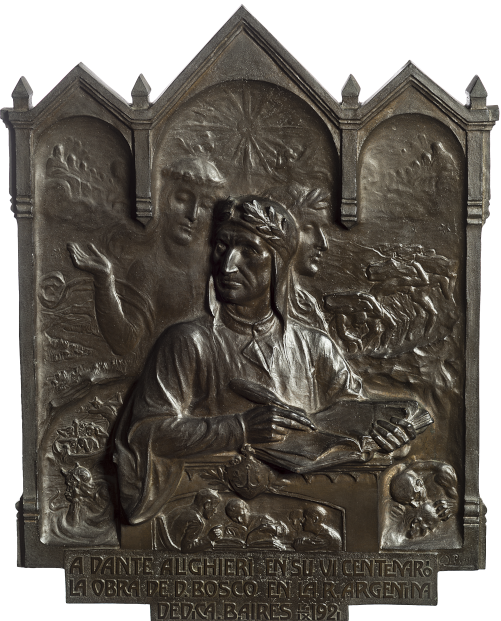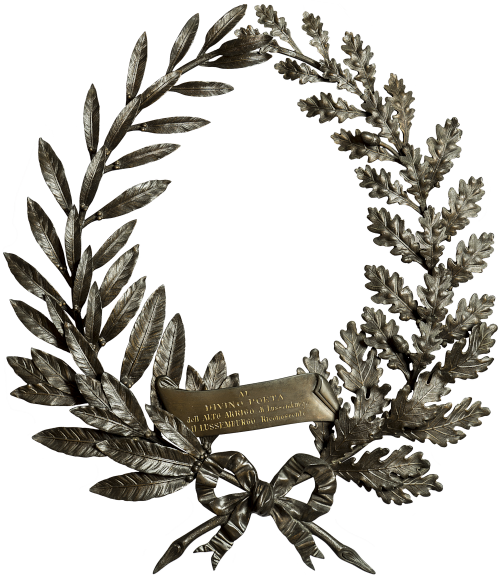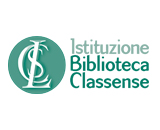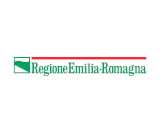The plaque was donated by the British movement “Amici d’Italia” in 1926. The poet is portrayed in profile within a crown of laurel. The plaque was created by the English artist Phoebe Stabler, very well-known in the ‘20s, also as a ceramic artist.
Manifattura Franci, Crown of Laurel, Siena, 1926, wrought iron, 111x90x15 cm.
Donated by the Italian Society for the Advancement of Science (SIPS), this crown was made by the company Franci of Siena, specializing in the production of wrought iron art works.
SIPS is a society bringing together scientists from all over Italy, originating in the nineteenth century but officially established in 1908. It promotes the advancement, knowledge and dissemination if science.
Crown from Pola, 1908, bronze, 49x42x7 cm.
This work, donated by the irredentist community of Pola (now Pula, Croatia), bears lines from Dante’s Inferno IX: “Pola near to the Quarnaro, that shuts in Italy and bathes its borders”.
The crown was donated in 1908: the Dante celebrations of that year were widely shared by the Istrian and Dalmatian cities, whose tribute to the father of the Italian language expressed a wish to soon become Italian themselves.
Dalmatian Crown, 1921, bronze, 110x118x29 cm.
This large bronze crown was an offering in Dante’s memory from a delegation of the people of Dalmatia, during the celebrations for the seventh centenary of Dante’s death, as commemorated by the inscription on the plaque, at the center of the wreath of oak leaves that comprise the work. The chest of the great eagle with outstretched wings bears the Dalmatian coat of arms: a shield with three crowned lions.
Crown from Siena, 1921, wrought iron, 120x107x10 cm.
This garland was a gift from the Siena section of the Dante Alighieri Society. In addition to the dedicatory plaque, it also features the emblems of the city: the coats of arms of the Republic of Siena (shield with the inscription “Libertas”), the Municipality (truncated shield) and the Captain of the People (shield with a rampant lion).
Crown from the Miners of Formignano, 1935, bronze, 33x31x3 cm.
This bronze crown is made up of two crossed branches, laurel on the left and oak on the right, held together with a ribbon bearing an inscription with the date of the offering (May 6, 1935). The laurel, used to crown Roman Emperors and leaders carried in triumph, is considered the noblest of plants and a symbol of glory. The Oak, a long-lived tree with especially strong wood, represents the solidity of the poet’s fame. It was a gift to Dante’s memory from the miners of Formignano, an important sulfur mining center near Cesena, in the province of Forlì-Cesena, active until the early 1970s./span>
Plaque from American students, 1921, bronze with gold decorations, 78x85x3 cm.
On August 2, 1921, students and teachers from Harvard and other American universities came to Ravenna to pay tribute to Dante in honor of the sixth centenary of his death. Welcomed by the Mayor, Fortunato Buzzi, they visited the Basilica of San Francesco, also known as “Dante’s church”, where the President of the Dante Memorial Association, John Slattery, gave a commemorative speech on behalf of the American delegation: “From far-off America, we have come to this ancient city, rich in living memories, especially to show our admiration for the life and genius of Dante and to bear witness to our love and our homage to his revered memory”.
Plaque from the Dante League of America, 1921, bronze, 41x37x3 cm.
Crown-shaped plaque with interwoven laurel and oak branches, symbolizing the poet’s eternal glory. A gift from the Dante League of America, this plaque was sent from New York on August 30, 1921.
E. C. Prampolini, Effigie di Dante (effigy of Dante), 1921, bronze, 43x30x3 cm.
A gift from the Angelo Secchi Royal Technical Institute of Reggio Emilia, this plaque features the iconographic frontal portrait of the poet, made famous, in particular, by the engraving entitled Dantes Adriacus by Adolfo De Carolis, dear to Gabriele D’Annunzio. The gift was brought to Dante’s Tomb on May 24, 1921.
Plaque of Dante from Argentina, 1921, bronze relief, 74x56x5 cm.
This plaque portrays the poet, in its center, intent on writing the Divine Comedy, references to which are made by the border of scenes and figures surrounding him: Beatrice and Virgil (depicted behind Dante), the Inferno (below, where there is also a scene showing three figures absorbed in the study of the Divine Comedy), the Purgatorio (center-right), and the Paradiso (top).
The skilled use of different levels of relief and the stiacciato (shallow relief) technique brings the composition to life and endows it with a good depth of perspective. The work was donated by the Work of Don Bosco of the Republic of Argentina on September 14, 1921.
Garland from Luxembourg, 1921, bronze, 73x62x5.
Brought to Dante’s Tomb on September 27, 1921, by the Luxembourgian delegation to commemorate the poet who immortalized Emperor Henry VII of Luxembourg, Holy Roman Emperor, as “the noble Henry” in Paradise XVII and XXX.
Umberto Bellotto, Commemorative Garland, 1921, wrought iron, 108x77x8 cm.
A gift from the Italians of Louisiana and New Orleans, this crown was brought to Ravenna by the delegated representatives on September 9, 1921.
The artist, the Venetian Umberto Bellotto, who also created the beautiful railing for the Quadrarco di Braccioforte garden, was famous for practicing both the art of glass-making and that of wrought iron work. His late liberty style is distinguished by highly unique forms tending towards technical virtuosity and revival of neo-medieval stylistic features. His work was highly esteemed by Gabriele D’Annunzio.
Door, 1921, wrought iron and glass, 213x89x14.5 cm.
Door decorated with a large palm branch reminiscent of the carved decorations of the woodwork of the setting; it was probably designed in line with the hall, although its original position is unknown.
Typically of the Arts & Crafts movement, to which the style of this small hall refers, attention is paid to each individual detail, from the cabinets to the frescoes and functional elements such as doors and windows, resulting in stylistically and decoratively harmonious and organic environments. Given the beauty of the overall decor, one cannot help but mourn the loss of the glass from the windows, destroyed during the bombings of Ravenna in 1943 and 1944, undoubtedly conceived in accordance with the other elements of the hall.


